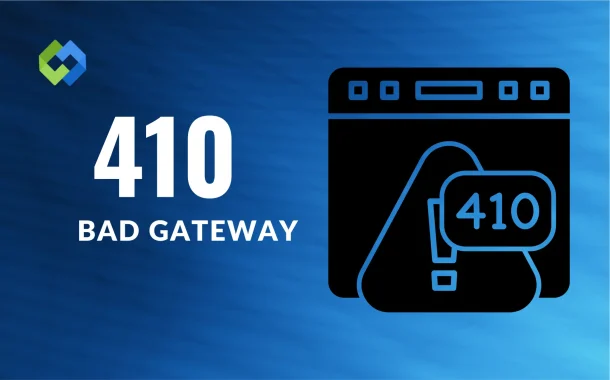The 410 Bad Gateway code is specific and means that a web page is gone permanently. It’s different from 404, which means the page is missing but might come back. Knowing about 410 is crucial because it impacts how search engines view your site and how users experience it. Fixing or managing 410 errors can help maintain your site’s credibility and performance.
Table of Contents
Table of Contents
What is a 410 Bad Gateway?
A 410 Bad Gateway is an HTTP status code indicating that the requested web page is no longer available and has been permanently removed. This response is sent by the server when it knows the resource has been intentionally deleted and won’t be available again.
Unlike the 404 error, which means the page is missing but might return, the 410 status tells users and search engines that the page is gone for good. It’s like a “permanent removal” notice.
This status code is useful for informing both visitors and search engines that the content has been intentionally deleted and will not be restored. Search engines will eventually stop trying to index the page, which helps in cleaning up old or outdated content.
Websites use the 410 status to manage and control their content better, ensuring that users don’t keep looking for pages that no longer exist. It helps maintain a clean and efficient user experience.
Common Causes of 410 Bad Gateway
- Content Permanently Removed: When website owners decide that certain pages are no longer relevant or useful, they may choose to permanently delete these pages. This could be due to outdated information, redundancy, or a change in business focus. The server then sends a 410 status code to indicate the permanent removal, signaling to both users and search engines that the content is intentionally gone.
- Server Configuration Changes: Changes in server settings or configurations, such as updates to the .htaccess file or other server directives, can lead to 410 errors. If the server is reconfigured to indicate that certain resources are no longer available, any requests to those resources will return a 410 status code. This is often part of broader server optimization or reorganization efforts.
- URL Structure Changes: During website redesigns or restructuring, URLs may be altered or removed entirely. If the old URLs are no longer valid and the content has been permanently removed without setting up proper redirects, the server will return a 410 status code for those URLs. This helps manage the transition by clearly indicating that the old content is not coming back.
- Manual Removal by Webmaster: Webmasters sometimes manually configure their servers to return a 410 status for specific pages. This might be part of a content cleanup process, where obsolete or unwanted pages are permanently removed from the site. By setting the 410 status, webmasters ensure that these pages are marked as permanently gone, both for users and search engines.
- Legal or Policy Reasons: In some cases, content must be removed due to legal issues, such as copyright infringement or regulatory compliance. When this happens, the server can be configured to return a 410 status code to indicate that the content has been permanently taken down. This helps to ensure that the removal is clearly communicated and that the content is not mistakenly requested again in the future.
Diagnose a 410 Bad Gateway
Check Server Logs
Start by examining the server logs, which provide detailed information about the requests made to the server and the responses it has sent. Look for entries that indicate a 410 status code. This will help you identify which URLs are returning the error and the context in which they are being requested.
Use Browser Developer Tools
Most modern web browsers come with built-in developer tools that can be used to inspect HTTP requests and responses. Open the developer tools, navigate to the Network tab, and reload the page that is returning the 410 error. This will show you the details of the request and response, including headers and status codes, helping you pinpoint the exact cause of the issue.
Analyze Server Configuration
Review the server configuration files, such as .htaccess (for Apache servers) or nginx.conf (for NGINX servers). Look for directives that might be causing the server to return a 410 status code. This could include rewrite rules, redirects, or custom error pages. Understanding these configurations can help you determine if the 410 status is being set intentionally or by mistake.
Check CMS Settings
If you are using a Content Management System (CMS), check its settings and content management features. Some CMS platforms allow you to permanently delete pages and automatically return a 410 status code for those URLs. Review any recent changes or deletions in the CMS to see if they correlate with the 410 errors.
Use Online Diagnostic Tools
There are various online tools available that can help diagnose HTTP status codes. Tools like HTTP status code checkers or website health analyzers can scan your site and provide detailed reports on which URLs are returning a 410 status. These tools often offer insights into possible causes and suggest solutions for fixing the errors.
Fixing a 410 Bad Gateway
By implementing these solutions, you can effectively resolve 410 Bad Gateway errors.
Server-Side Solutions
- Correcting Server Configurations: Review and update your server configuration files, such as .htaccess (Apache) or nginx.conf (NGINX), to ensure that no incorrect directives are causing the 410 errors. If you find rules or settings that are leading to these errors unintentionally, correct them to allow the pages to be served correctly.
- Restoring Removed Content: If the content was removed by mistake, restore it from a backup or recreate it. Once the content is restored, the server should no longer return a 410 status for those URLs. Ensure that the restored content is up-to-date and relevant to avoid future removals.
Client-Side Solutions
- Clearing Cache and Cookies: Sometimes, cached data or cookies on the client-side can cause persistent errors. Clear the browser cache and cookies, then try accessing the page again. This ensures that the latest version of the page is requested from the server.
- Checking Internet Connection: Ensure that your internet connection is stable. Intermittent connection issues can sometimes cause errors that mimic server-side problems. Verify your connection and try accessing the website from a different network if necessary.
Setting Up Proper Redirects
- 301 Redirects for Permanently Moved Content: If the content has been moved to a new URL, set up a 301 redirect from the old URL to the new one. This informs both users and search engines that the content has moved permanently, preserving SEO value and user access.
- Custom 404 Page for Removed Content: If the content is gone for good and you don’t want to restore it, consider setting up a custom 404 page instead of returning a 410 status. This provides a better user experience by guiding users to other relevant content on your site.
Updating Links and References
- Internal Links: Check your website for any internal links that point to the URLs returning a 410 status. Update these links to point to the correct or alternative content to improve navigation and user experience.
- External Links: If other websites link to the pages that have been removed, reach out to the webmasters of those sites and request an update to the new URLs or suggest alternative relevant content.
Monitoring and Maintenance
- Regular Site Audits: Conduct regular audits of your website to identify and fix any 410 errors promptly. Use tools like Google Search Console to monitor the health of your site and receive alerts about crawling issues.
- Content Management: Implement a robust content management strategy to ensure that only necessary and relevant content is published. Regularly review and update your content to prevent unnecessary removals that could lead to 410 errors.
FAQs
What is the difference between a 410 and a 404 error?
A 404 error means the page is not found but might come back in the future, suggesting it could be a temporary issue. A 410 error, on the other hand, means the page has been permanently removed and will not return, signaling to users and search engines that the content is gone for good.
How does a 410 error affect SEO?
A 410 error tells search engines to remove the page from their index, which helps clean up your site’s search results by removing non-existent pages. However, it can also impact traffic if not managed properly, especially if the removed page had significant SEO value. It’s important to handle 410 errors carefully to avoid losing valuable traffic.
Can users still access a page with a 410 error?
No, users cannot access a page with a 410 error because it indicates the page has been permanently removed. When they try to visit the URL, they will receive a message indicating that the page is no longer available, and they should not expect it to return.
How do I know if a 410 error is intentional or a mistake?
To determine if a 410 error is intentional, check your server configuration files and logs to see if the status code was set deliberately. Also, review any recent changes to your website, such as content deletions or server updates. If you find no reason for the 410 error, it might be a mistake that needs to be corrected.
Can a 410 error be fixed by creating a new page with the same URL?
Yes, if you create new content with the same URL, the 410 error will be resolved. The server will start serving the new content, and users will be able to access the page again. This approach can restore traffic to that URL and ensure that users find the content they are looking for.
Conclusion
410 Bad Gateway error is essential for website owners and users alike. This status code indicates that a web page has been permanently removed and will not return. Unlike a 404 error, which suggests the page might come back, a 410 error clearly tells everyone that the content is gone for good. Knowing this difference helps in managing website health and user expectations.
To address a 410 error, it’s important to diagnose its cause, whether it’s due to content removal or server configuration issues. Taking appropriate action, like restoring content or setting up proper redirects, can improve user experience and maintain SEO value. Regularly monitoring your website can help prevent future issues and keep your content relevant and accessible.














